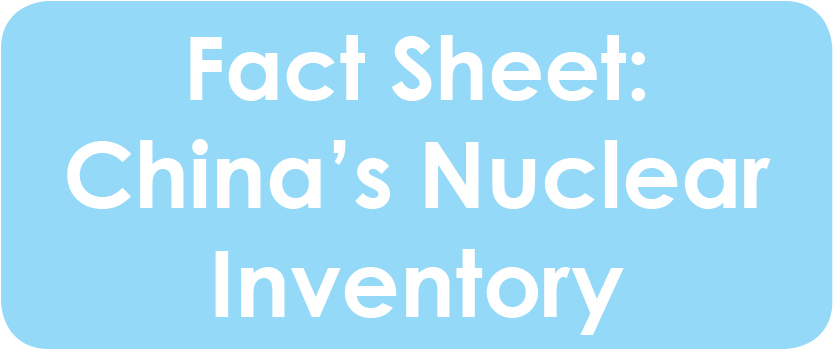 Based on recent trends and available source material, it is estimated that China has approximately 500 nuclear warheads that can be delivered by air, sea and land, with its nuclear arsenal likely to increase in the next few decades. There are several unknowns that complicate our picture of Chinese strategic force numbers, however. China provides no official data on its nuclear forces and stringently controls messaging surrounding them. Moreover, ongoing Chinese efforts to expand ICBM silo fields and modernize its sea-based fleet have tended to color analytical projections toward high-end bias. But there are many unknowns that could determine China’s force totals in the years ahead, including the total number of silo fields constructed, the total number of silos loaded, how many warheads each missile will carry, as well as China’s fissile material output. China’s nuclear strategy centers around deterrence through “assured retaliation.” This means it is possible that China seeks to be able to survive a theoretical first strike and retaliate proportionately. China keeps its nuclear weapons on low alert, meaning warheads and missiles are stored separately until they are paired in preparation for a strike. Consistent with its nuclear posture, China maintains a No First Use policy (NFU). This longstanding policy states that China will never be the first to use a nuclear weapon in a conflict, and only ever in retaliation of a nuclear attack. Chinese doctrine can and will be affected by the choices of other nuclear weapon states. For example, if the United States continues to expand and strengthen its missile defense program, China may modify its nuclear posture to include a significantly larger nuclear force with the potential to strike the United States. In viewing recent Chinese statements and investments, some experts have begun to question China’s NFU policy.
Based on recent trends and available source material, it is estimated that China has approximately 500 nuclear warheads that can be delivered by air, sea and land, with its nuclear arsenal likely to increase in the next few decades. There are several unknowns that complicate our picture of Chinese strategic force numbers, however. China provides no official data on its nuclear forces and stringently controls messaging surrounding them. Moreover, ongoing Chinese efforts to expand ICBM silo fields and modernize its sea-based fleet have tended to color analytical projections toward high-end bias. But there are many unknowns that could determine China’s force totals in the years ahead, including the total number of silo fields constructed, the total number of silos loaded, how many warheads each missile will carry, as well as China’s fissile material output. China’s nuclear strategy centers around deterrence through “assured retaliation.” This means it is possible that China seeks to be able to survive a theoretical first strike and retaliate proportionately. China keeps its nuclear weapons on low alert, meaning warheads and missiles are stored separately until they are paired in preparation for a strike. Consistent with its nuclear posture, China maintains a No First Use policy (NFU). This longstanding policy states that China will never be the first to use a nuclear weapon in a conflict, and only ever in retaliation of a nuclear attack. Chinese doctrine can and will be affected by the choices of other nuclear weapon states. For example, if the United States continues to expand and strengthen its missile defense program, China may modify its nuclear posture to include a significantly larger nuclear force with the potential to strike the United States. In viewing recent Chinese statements and investments, some experts have begun to question China’s NFU policy.
Only months later, China displayed its military might during its National Day parade by showcasing the three components of a nuclear triad: ground-based intercontinental ballistic missiles, submarine-launched missiles and air-launched weapons. Like many other nuclear-armed states, China is currently modernizing all three legs of its triad. Many analysts believe that China’s nuclear investments indicate it is more interested in establishing its regional dominance to deter powers like Russia and India, rather than its desire to be a great power competitor. While the Trump administration sought a trilateral arms control deal with China and Russia, Beijing ultimately declined to enter talks given its significantly smaller arsenal.
While China has yet to accept U.S. offers for strategic dialogue, the Biden administration has signaled that it will seek to engage China on nuclear arms control and risk reduction.
Recent Analysis on China
- The U.S. Missile Launcher That Is Enraging China March 25, 2025
- Op-ed: China’s military mishaps don’t add up to strategic weakness November 15, 2024
- Addressing the China Challenge: The Fallacy of Relying on a Cold War Lens for Nuclear Issues September 18, 2024
- Op-ed: Nuclear Shadows Over South Asia: Strategic Instabilities in the China-India-Pakistan Triad August 9, 2024
- Op-Ed: Risk reduction can help prevent nuclear crises. Here’s how. March 22, 2024
- India’s Agni-5 missile: Deterrence against China or is New Delhi thinking something bigger? March 21, 2024
- 5 Potential Points for Bipartisanship on Nuclear Issues in 2024 January 5, 2024
- The China Dilemma November 13, 2023
- Fact Sheet: The Sino-Soviet Border Dispute November 13, 2023
- Drivers of China’s nuclear build-up August 17, 2023

